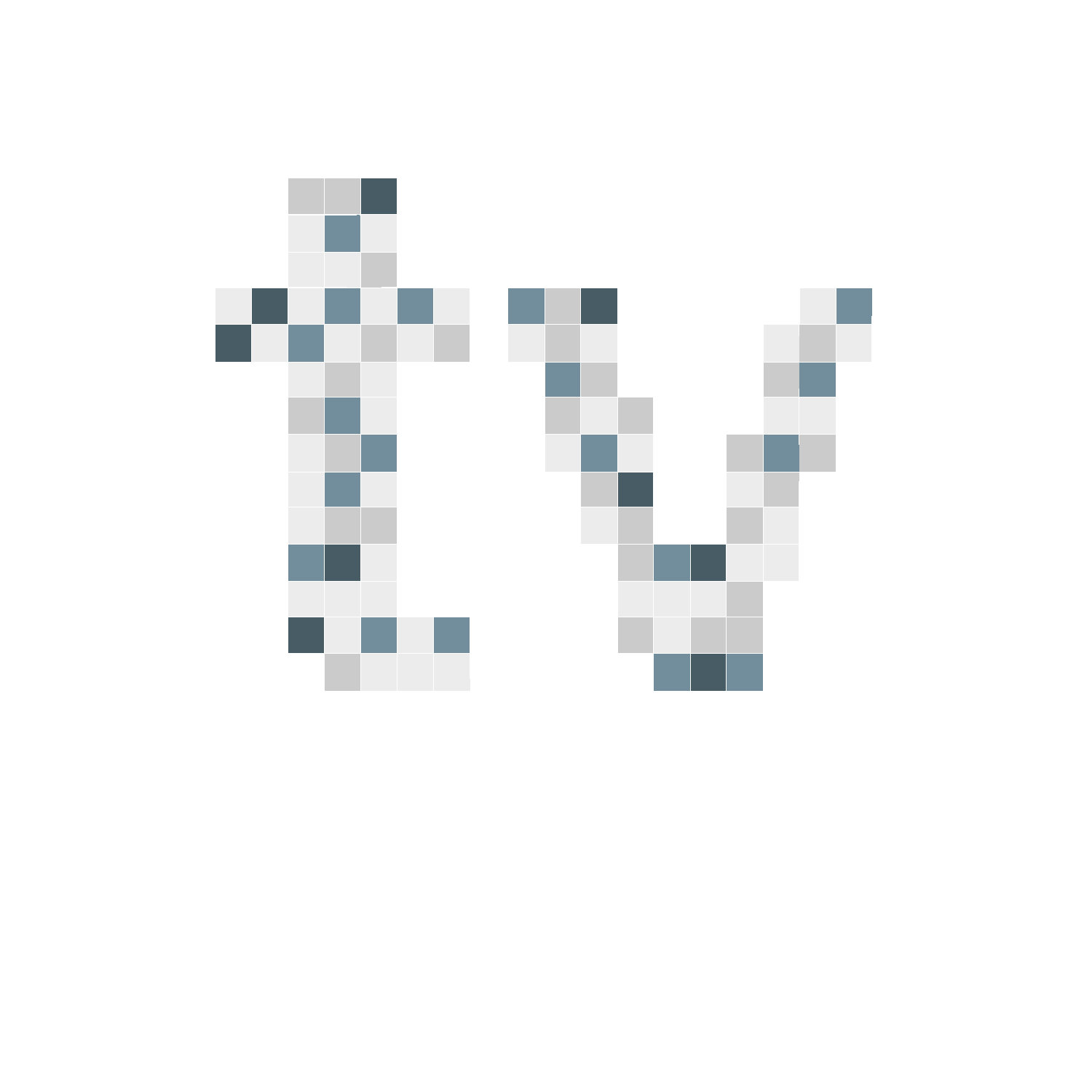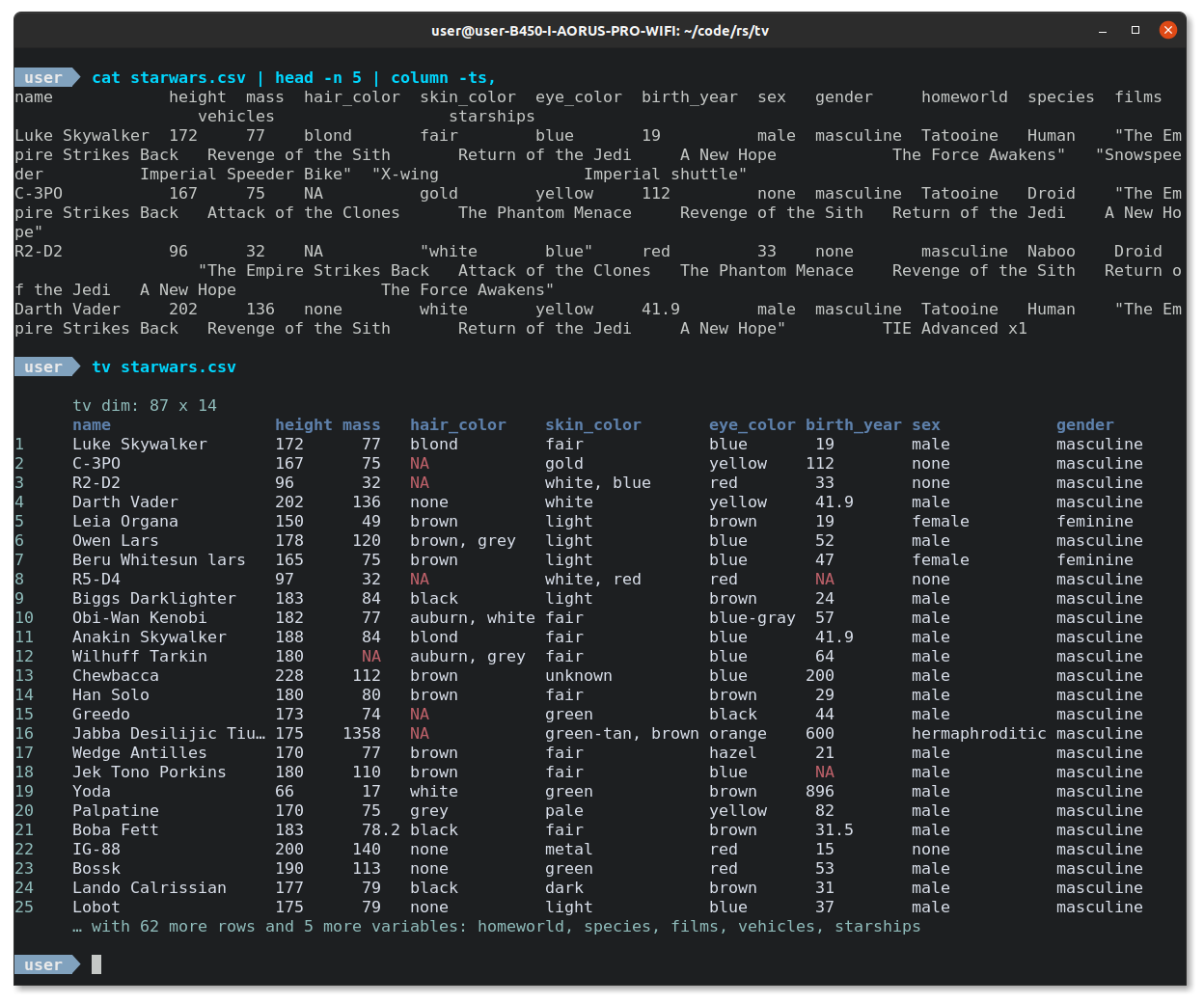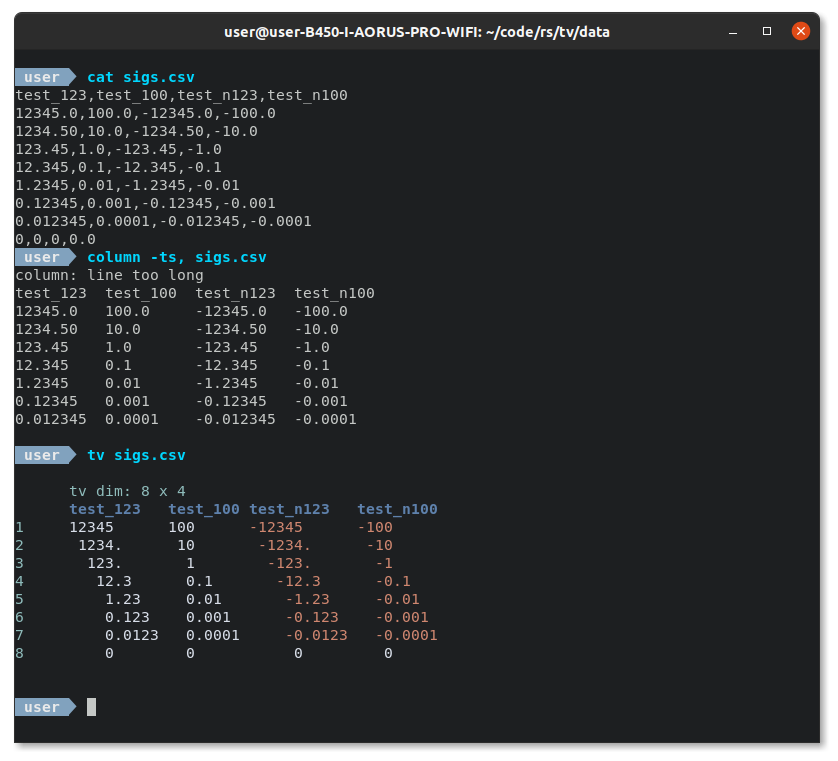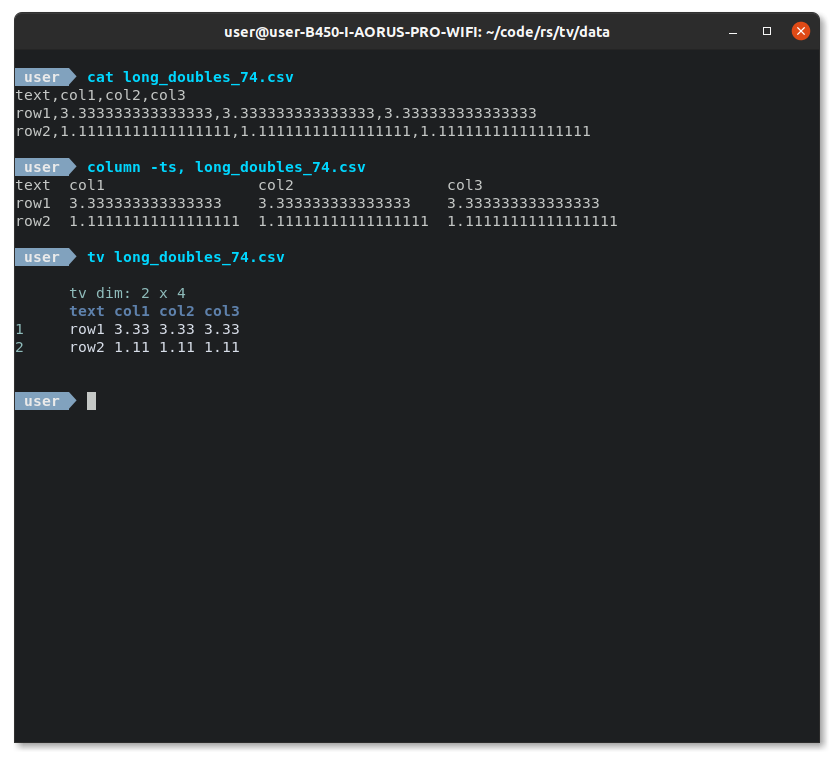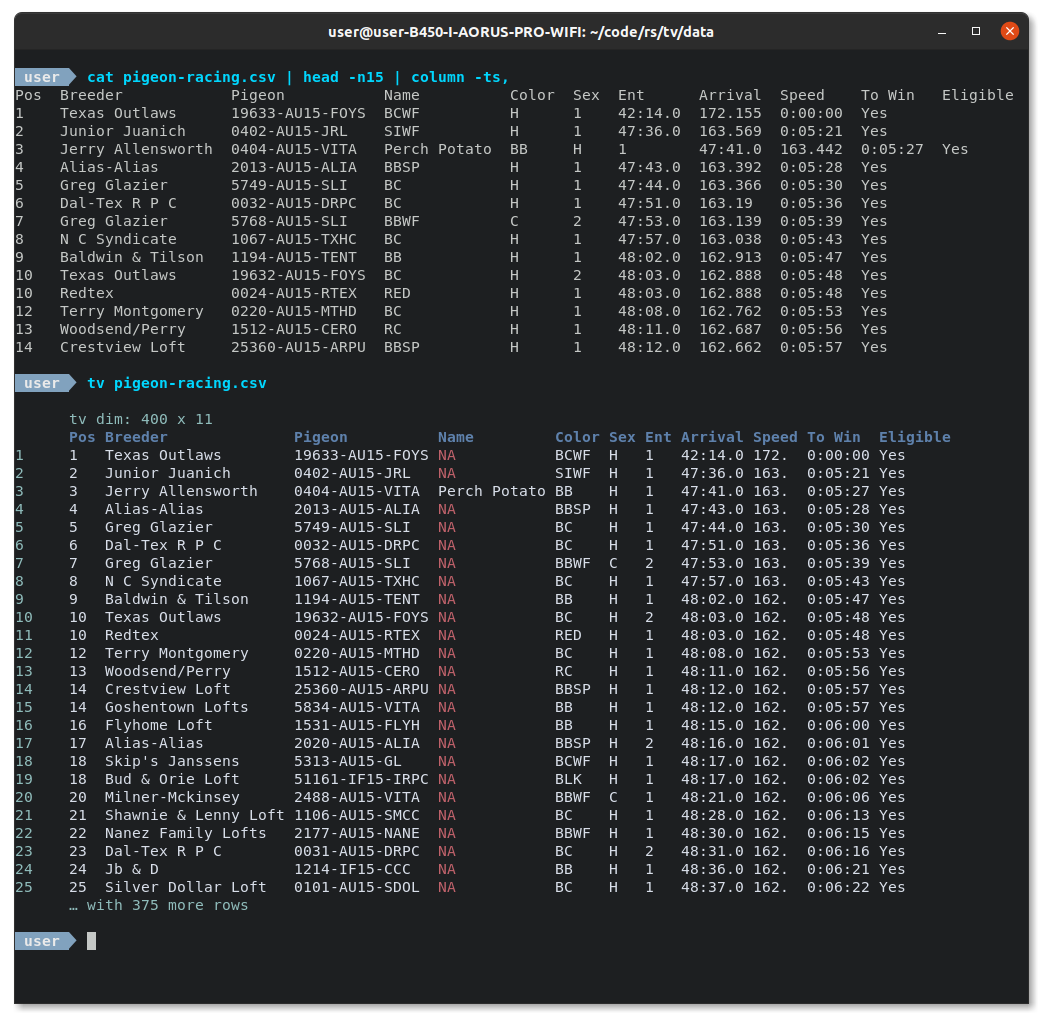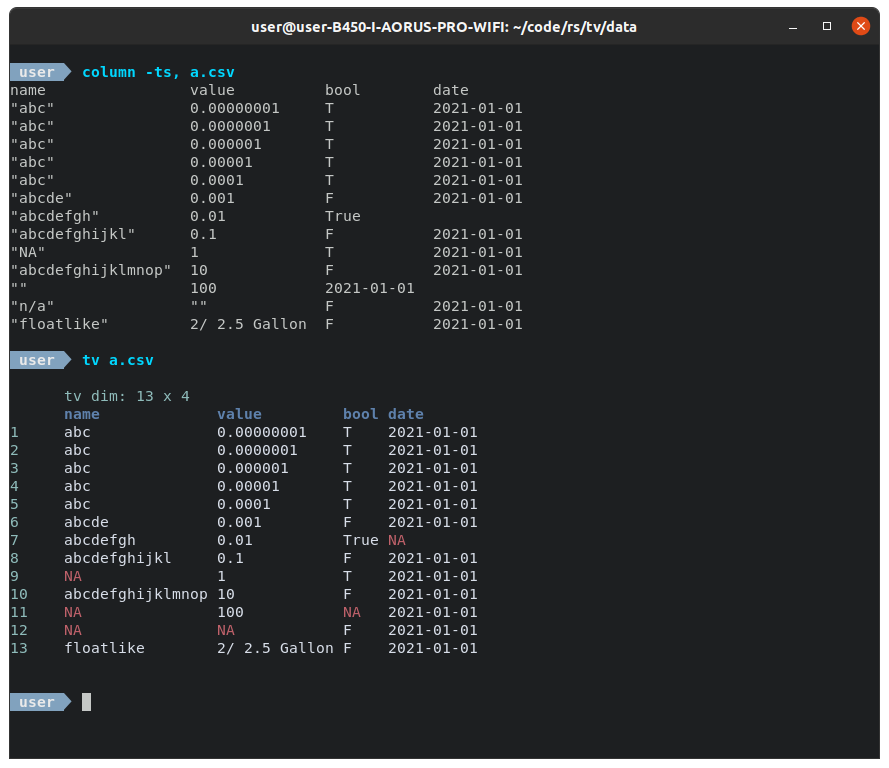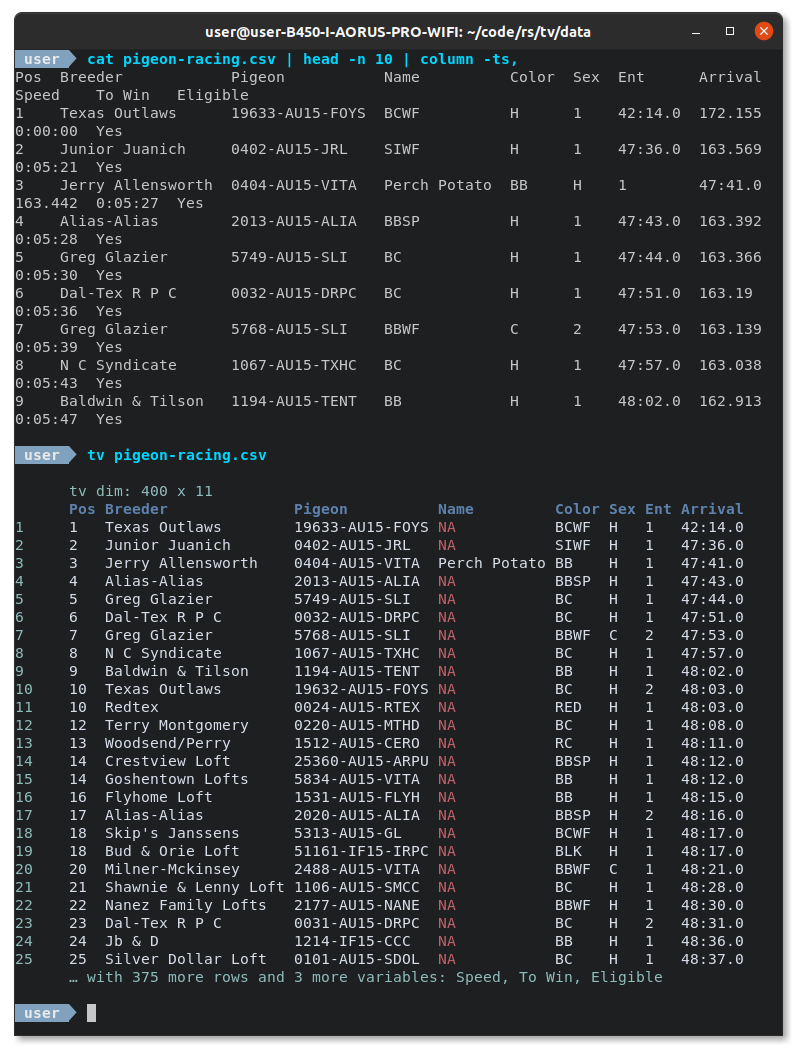Tidy Viewer (tv) is a cross-platform csv pretty printer that uses column styling to maximize viewer enjoyment.
- Features
- Installation
- Examples
- Significant Figure Definitions & Rules
- Tools to pair with
tv - Configuration Dotfile
- FAQ
- Help
- Inspiration
- Nice colors out of the box
- Significant digit printing (no more decimal dust taking valuable terminal space)
- NA comprehension and coloring (no more misaligned data cells due to missing data)
- Dimensions printed first (no more guessing how many rows and columns are in the data)
- Column overflow logic (no more misalignment due to terminal dimensions)
- Long string/Unicode truncation (no more long strings pushing other data around)
- Customizable with a dotfile config (bring your own theme)
The following install options are available via package managers:
We currently cut releases for the following architectures. Download from the release page.
- MacOS
- ARM
- Windows
- Build from source (Most general)
The instructions for all of the above are very similar with the following general steps.
- Download your desired release from the release page
tar -xvzf <RELEASE_FILE_NAME>cdinto uncompressed folder- Find binary
tidy-viewer
After the above steps I would highly recommend you make an alias for tidy-viewer as shown for other builds.
The following will install from the crates.io source. For convenience add the alas alias tv='tidy-viewer' to .bashrc.
cargo install tidy-viewer
sudo cp /home/$USER/.cargo/bin/tidy-viewer /usr/local/bin/.
echo "alias tv='tidy-viewer'" >> ~/.bashrc
source ~/.bashrcThe below instructions work with the most recent release <VERSION> found here release page.
wget https://github.com/alexhallam/tv/releases/download/<VERSION>/tidy-viewer_<VERSION>_amd64.deb
sudo dpkg -i tidy-viewer_<VERSION>_amd64.deb
echo "alias tv='tidy-viewer'" >> ~/.bashrc
source ~/.bashrcKindly maintained by @yigitsever
paru -S tidy-viewersudo snap install --edge tidy-viewer
brew install tidy-viewer
Have some fun with the following datasets!
# Download the diamonds data
wget https://raw.githubusercontent.com/tidyverse/ggplot2/master/data-raw/diamonds.csv
# pipe to tv
cat diamonds.csv | tvwget https://raw.githubusercontent.com/tidyverse/dplyr/master/data-raw/starwars.csv
# Pass as argument
tv starwars.csvwget https://raw.githubusercontent.com/joanby/python-ml-course/master/datasets/pigeon-race/pigeon-racing.csv
cat pigeon-racing.csv | tvwget https://raw.githubusercontent.com/datasciencedojo/datasets/master/titanic.csv
# send to pager with color
# less
tv titanic.csv -ea | less -R
# bat
tv titanic.csv -a -n 1000 | bat -pThe first three digits represent > 99.9% the value of a number. -- GNU-R Pillar
Choosing the sigfigs amounts to how much of the value of a number is desired. The table below shows an example calculation with variable sigfigs.
| sigfigs | value | sigfiged_value | %value_of_the_number_explained_by_sigfiged_vale |
|---|---|---|---|
| 1 | 0.1119 | 0.1 | >89% |
| 2 | 0.1119 | 0.11 | >98% |
| 3 | 0.1119 | 0.111 | >99% |
tv uses the same significant figure (sigfig) rules that the R package pillar uses.
The purpose of the sigfig rules in tv is to guide the eye to the most important information in a number. This section defines terms and the decision tree used in the calculation of the final value displayed.
┌─────┐ ┌─────┐ ─┐
│ │ │ │ │
│ │ │ │ │
│ │ │ │ │
│ │ │ │ │
│ │ ┌┐ │ │ │
└─────┘ └┘ └─────┘ ──┴─
│ │ │ │
└────────┘ ▲ └────────────────┘
left hand side │ right hand side
(lhs) │ (rhs)
decimal
left hand side (lhs): digits on the left hand side of the decimal.
right hand side (rhs): digits on the right hand side of the decimal.
┌─────┐ ┌─────┐ ─┐ ┌─────┐
│ │ │ │ │ │ │
│ │ │ │ │ │ │
│ │ │ │ │ │ │
│ │ │ │ │ │ │
│ │ ┌┐ │ │ │ │ │
└─────┘ └┘ └─────┘ ──┴─ └─────┘
│ │ │ │
└─────────────────────┘ └───────┘
leading 0s trailing 0s
leading 0s: 0s to the left of a non-zero.
trailing 0s: 0s to the right of a non-zero. The zeros in 500m are trailing as well as the 0s in 0.500km.
─┐ ┌─────┐ ─┐
│ │ │ │
│ │ │ │
│ │ │ │
│ │ │ │
│ │ │ ┌┐ │
──┴─ └─────┘ └┘ ──┴─
│ │
└────────┘
fractional digit(s)
fractional digits: Digits on the rhs of the decimal. The represent the non-integer part of a number.
There are only 4 outputs possible. The significant figures to display are set by the user. Assume sigfig = 3:
- lhs only (
12345.0 -> 12345): If no fractional digits are present and lhs >= sigfig then return lhs - lhs + point (
1234.5 -> 1234.): If fractional digits are present and lhs >= sigfig then return lhs with point. This is to let the user know that some decimal dust is beyond the main mass of the number. - lhs + point + rhs (
1.2345 -> 1.23): If fractional digits are present and lhs < sigfig return the first three digits of the number. - long rhs (
0.00001 -> 0.00001): This is reserved for values with leading 0s in the rhs.
# Pseudo Code: Sigfig logic assuming sigfig = 3
if lhs == 0:
n = ((floor(log10(abs(x))) + 1 - sigfig)
r =(10^n) * round(x / (10^n))
return r
// (0.12345 -> 0.123)
else:
if log10(lhs) + 1 > sigfig:
if rhs > 0:
//concatenate:
//(lhs)
//(point)
//(123.45 -> 123.)
else:
//concatenate:
//(lhs)
//(1234.0 -> 1234)
//(100.0 -> 100)
else:
//concatenate:
//(lhs)
//(point)
//sigfig - log10(lhs) from rhs
//(12.345 -> 12.3)
//(1.2345 -> 1.23)
tv is a good complement to command line data manipulation tools. I have listed some tools that I like to use with tv.
qsv - Fork of xsv. Has more commands/subcommands and allows users to evaluate lua/python on data. [Rust | CLI]
xsv - Command line csv data manipulation. [Rust | CLI]
SQLite - Database engine with CLU, shell, and library interfaces . [C | CLI/shell/lib]
DuckDB - Database engine with CLU, shell, and library interfaces . [C++ | CLI/shell/lib]
csvtk - Command line csv data manipulation. [Go | CLI]
tsv-utils - Command line csv data manipulation toolkit. [D | CLI]
q - Command line csv data manipulation query-like. [Python | CLI]
miller - Command line data manipulation, statistics, and more. [C | CLI]
VisiData - An interactive terminal user interface that is built to explore and wrangle data. [Python | TUI]
column Comes standard with Linux. To get similar functionality run column file.csv -ts,
Though column is similar I do think there are some reasons tv is a better tool.
NA values are very important! Viewers should have their attention drawn to these empty cells. In the image below NA values are not only invisible, but it seems to be causing incorrect alignment in other columns.
There are many ways that programs will designate missing values. Some use none, others use NaN, and many more "", NA, null, n/a etc. tv searches for these strings and replaces them with NA. This is similar in spirit to the significant digit calculations and the truncation of columns with long strings. The purpose of tv is not to show the complete literal value, but to guide the eye.
In cases where the terminal width can't fit all of the columns in a dataframe, column will try to smush data on the rows below. This results in an unpleasant viewing experience.
tv can automatically tell when there will be too many columns to print. When this occurs it will only print the columns that fit in the terminal and mention the extras in the footer below the table.
For information on dotfile configuration see tv --help. This allows users to set their own color palette, rows to print, max column width, etc.
- Does
tvhave a light theme?
Yes, solorized light is added out of the box. This was added in version
1.4.6. You may also define your own themes in the config.
- The
~/.config/tv.tomlfile is having no effect on the output. What am I doing wrong?
Every key/value pair must exist or the toml will not be read. If even one key/value is missing then the config will not work.
- It would be nice to be able to scroll vertically/horizontally through tall/wide csv file. Does
tvallow for this functionality?
Yes, pipe the output to
lessorbat.tvallows for this with the-eflag. To extend to the full csv width and length and keep color try the followingtv diamonds.csv -ea | less -SRTo extend to the full csv width and length and remove all color try the followingtv diamonds.csv -e | less -S
tv --help
tv 1.5.2
Tidy Viewer (tv) is a csv pretty printer that uses column styling to maximize viewer enjoyment.✨✨📺✨✨
Example Usage:
wget https://raw.githubusercontent.com/tidyverse/ggplot2/master/data-raw/diamonds.csv
cat diamonds.csv | head -n 35 | tv
tv diamonds.csv
Configuration File Support:
An example config is printed to make it easy to copy/paste to `tv.toml`.
Check the parameters you have changed with `tv --config-details`.
The config (tv.toml) location is dependent on OS:
* Linux: $XDG_CONFIG_HOME or $HOME/.config/tv.toml
* macOS: $HOME/Library/Application Support/tv.toml
* Windows: {FOLDERID_RoamingAppData}\tv.toml
## ==Tidy-Viewer Config Example==
## Remove the first column of comments for valid toml file
## All fields must be defined. Partial files will not be read.
## The delimiter separating the columns. [default: ,]
#delimiter = ","
## Add a title to your tv. Example 'Test Data' [default: NA ("")]
#title = ""
## Add a footer to your tv. Example 'footer info' [default: NA ("")]
#footer = ""
## The upper (maximum) width of columns. [default: 20]
#upper_column_width = 20
## The minimum width of columns. Must be 2 or larger. [default: 2]
#lower_column_width = 2
## head number of rows to output <row-display> [default: 25]
#number = 35
## extend width and length in terms of the number of rows and columns displayed beyond term width [default: false]
# extend_width_length = true
## meta_color = [R,G,B] color for row index and "tv dim: rows x cols"
#meta_color = [64, 179, 162]
## header_color = [R,G,B] color for column headers
#header_color = [232, 168, 124]
## std_color = [R,G,B] color for standard cell data values
#std_color = [133, 205, 202]
## na_color = [R,G,B] color for NA values
#na_color = [226, 125, 95]
## neg_num_color = [R,G,B] color for negative values
#neg_num_color = [226, 125, 95]
USAGE:
tidy-viewer [FLAGS] [OPTIONS] [FILE]
FLAGS:
-C, --config-details Show the current config details
-d, --debug-mode Print object details to make it easier for the maintainer to find and resolve bugs.
-e, --extend-width-and-length Extended width beyond term width (do not truncate). Useful with `less -S`.
-f, --force-all-rows Print all rows in file. May be piped to 'less -S'. Example `tidy-viewer
data/diamonds.csv -f -a | less -R`
-a, --color-always Always force color output. Example `tv -a starwars.csv | less -R` or `tv -a
starwars.csv | bat -p`. The `less` cli has the `-R` flag to parse colored output.
-h, --help Prints help information
-D, --no-dimensions Turns off dimensions of the data
-R, --no-row-numbering Turns off row numbering
-V, --version Prints version information
OPTIONS:
-c, --color <color>
There are 5 preconfigured color palettes (Defaults to nord):
(1)nord
(2)one_dark
(3)gruvbox
(4)dracula
(5)solarized light [default: 0]
-s, --delimiter <delimiter> The delimiter separating the columns.
-F, --footer <footer> Add a footer to your tv. Example 'footer info' [default: NA]
-l, --lower-column-width <lower-column-width>
The lower (minimum) width of columns. Must be 2 or larger. [default: 2]
-n, --number-of-rows-to-output <row-display> Show how many rows to display. [default: 25]
-g, --sigfig <sigfig> Significant Digits. Default 3. Max is 7 [default: 3]
-t, --title <title> Add a title to your tv. Example 'Test Data' [default: NA]
-u, --upper-column-width <upper-column-width> The upper (maximum) width of columns. [default: 20]
ARGS:
<FILE> File to processHere I show how to use tv with a couple of database engines (SQLite, DuckDB).
Sqlite is a fantastic program! If it is not the most deployed software it is probably close to it. For more info on SQLite see their Executive Summary
For this example you will need to download and uncompress taxi data
wget https://github.com/multiprocessio/dsq/blob/43e72ff1d2c871082fed0ae401dd59e2ff9f6cfe/testdata/taxi.csv.7z?raw=true -O taxi.csv.7z
7z x taxi.csv.7z
cd testdata
ls -l --block-size=M # the data is farily large at 192MBsqlite3 :memory: -csv -header -cmd '.import taxi.csv taxi' 'SELECT passenger_count, COUNT(*), AVG(total_amount) FROM taxi GROUP BY passenger_count' | tvThe above one-liner queries a csv as an in-memory database. It is also possible to query an existing sqlite database and pipe the output as a csv for tv to pick up. A one-liner is shown below.
sqlite3 -csv -header <file_name.sqlite> 'select * from <table>;' | tvDuckDB has a lot in common with SQLite. As personal anecdotes I do like that fewer CLI flags are needed to run on csvs. I also like the speed. Though it is not as universal as SQLite I think that it is a good fit for command line data manipulation.
For this example you will need to download and uncompress taxi data
wget https://github.com/multiprocessio/dsq/blob/43e72ff1d2c871082fed0ae401dd59e2ff9f6cfe/testdata/taxi.csv.7z?raw=true -O taxi.csv.7z
7z x taxi.csv.7z
cd testdata
ls -l --block-size=M # the data is fairly large at 192MBUsing duckdb with tv and less to manipulate data with SQL grammar and view results in a scrolling window.
duckdb --csv -c "select norm1 from norms.csv" | ../target/release/tidy-viewer -f -a | less -Rduckdb --csv -c "SELECT passenger_count, COUNT(*), AVG(total_amount) FROM taxi.csv GROUP BY passenger_count ORDER BY passenger_count" | tvpillar - R's tibble like formatting. Fantastic original work by Kirill Müller and Hadley Wickham. tv makes an attempt to port their ideas to the terminal.



